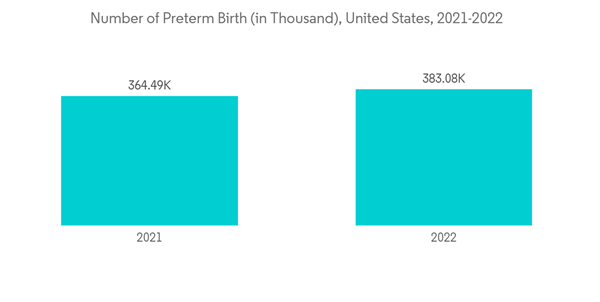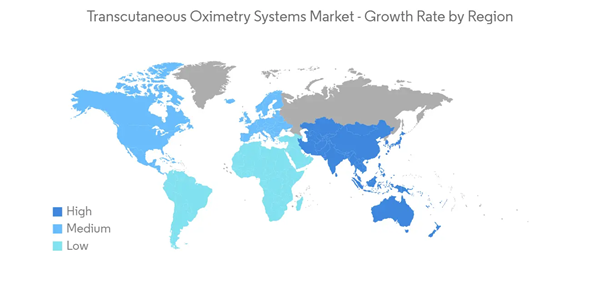The COVID-19 pandemic significantly impacted the transcutaneous oximetry systems due to the rapidly decreasing levels of oxygen in COVID-19-infected patients, which lead to requiring continuous monitoring. For instance, as per the article published in June 2021 in BMC journal, during the pandemic, transcutaneous pulse oximetry was conducted on hospital-admitted patients to understand the oxygen levels in the COVID-19-infected patients. Hence, the COVID-19 pandemic had a favorable impact on the market initially, currently as the pandemic has subsided the market has lost some traction and is expected to have stable growth during the forecast period of the study due to the rise of peripheral vascular diseases and an increase in diabetic cases.
The transcutaneous oximetry systems market is expected to account for significant growth owing to the increasing prevalence of peripheral vascular disorders and wound healing disorders. Typical and frequent wound-healing disorders are circulatory deficiency, malnutrition, metabolic disorders, sepsis, and additional inflammation. According to the Global Hunger Index, as of May 2022, 1.5 million children under the age of five, 45% of Somalia's children were projected to face acute malnutrition through the end of the year, including 386,400 who were expected to be severely malnourished. Thus, an increase in malnutrition leads to a slowdown of wound healing which thereby decrease the blood oxygen level at the site of injury. In such instances, for measuring oxygen levels, transcutaneous oximetry systems are widely used and thereby driving the market growth over the forecast period.
Moreover, the rise in the utilization of transcutaneous oximetry systems in peripheral vascular disorders to detect the systems is expected to fuel market growth. For instance, as per the article published in November 2022 in PubMed, the study showed that in patients with suspected thoracic outlet syndrome (TOS), transcutaneous oximetry (TcpO2) can be used for detecting upper limb arterial compression and/or symptoms during arm abduction. Transcutaneous oximetry systems are also gaining popularity to check the need for amputation. A diabetic foot ulcer is a major reason for foot amputation. An article published by National Center for Biotechnology Information in August 2022 stated that diabetic foot ulcers are among the most prevalent complications of people with diabetes mellitus and can be brought on by inadequate glycemic control, underlying neuropathy, peripheral vascular disease, or improper foot care. About 60% of diabetics develop neuropathy, eventually leading to a foot ulcer. The annual incidence of diabetic foot ulcers worldwide is between 9.1 to 26.1 million. Around 15 to 25% of patients with diabetes mellitus are likely to develop a diabetic foot ulcer during their lifetime. With the rising prevalence of newly diagnosed diabetes, the incidence of diabetic foot ulcers is also bound to increase. Also, the growing adoption of advanced monitoring systems for blood flow monitoring is expected to favor the demand for transcutaneous oximetry systems.
Thus, the rise in peripheral vascular disorders, diabetic mellitus, and the increase in the adoption of transcutaneous oximetry systems for detecting the oxygen levels in various diseases are expected to drive the market growth. However, the high cost of transcutaneous oximetry systems is expected to restrain market growth.
Transcutaneous Oximetry Systems Market Trends
Preterm Births are Expected to Register High Growth Over the Forecast Period
The preterm births segment is expected to witness significant market growth due to the increase in preterm births across the globe in which premature babies in the NICU are fragile and at risk of sudden changes in oxygenation and carbon dioxide levels, which can cause severe complications. Transcutaneous monitoring in neonates provides a real-time overview of the patient's often fluctuating oxygenation (tcpO2) and ventilation (tcpCO2) status. For instance, as per the November 2022 update by WHO, every year, an estimated 15 million babies are born preterm (before 37 completed weeks of gestation).Moreover, as per the article published in May 2022 in the Paediatric Medicine journal, transcutaneous oxygen monitoring, and pulse oximetry were both widely adopted by neonatal clinicians for many years. Even though, pulse oximeters are less suitable than transcutaneous pO2 (tcpO2) monitors for detecting dangerous hyperoxemia in extremely preterm infants. This is because large changes in oxygen tension may lead to small or no changes in saturations because of the flattening of the upper part of the S-shaped oxygen dissociation curve. Thus, owing to the increase in advantages offered by the transcutaneous oxygen system in preterm births than other oximeters, the studied segment is expected to witness significant growth over the forecast period.
Hence, due to the increase in preterm births and the increase in the utilization of transcutaneous oximetry systems for detecting the oxygen levels in preterm births are expected to drive the segment growth.
North America Anticipated to Hold a Significant Market Share Over the Forecast Period
North America is expected to hold a significant market share in the studied market over the forecast period owing to the factors such as an increase in the prevalence of peripheral vascular disorders, wound healing disorders, a rise in preterm births, and a surge in research and development in the region. For instance, as per the November 2022 update in CDC, in 2021, the rate of preterm birth among African American women (14.8%) was about 50% higher than the rate of preterm birth among white or Hispanic women (9.5% and 10.2% respectively). In 2021, preterm birth affected about 1 of every 10 infants born in the United States.Moreover, the growing prevalence of diabetes along with an increase in spending on healthcare management is anticipated to increase the market growth. For instance, according to the International Diabetes Federation Diabetes Atlas Tenth edition, in 2021, around 32.2 million people in the United States had diabetes, projected to grow to 36.3 million by 2045. The rising number of diabetic cases in the nation is expected to increase the number of diabetic ulcer cases and contribute to market growth in the studied region. Furthermore, as per the August 2022 update in NIH, transcutaneous oximetry recently become increasingly popular for wound assessment and patient selection for hyperbaric oxygen therapy (HBOT). Thus, owing to the increase in advantages offered by the transcutaneous oximetry systems is expected to fuel the market growth.
Hence, the rise in diabetic mellitus and the increase in preterm births are expected to drive market growth in North America over the forecast period.
Transcutaneous Oximetry Systems Industry Overview
The transcutaneous oximetry systems market is consolidated in nature. Market leaders with more funds for research and better distribution systems have established their position in the market.The major manufacturers operating in the transcutaneous oximetry systems market are Perimed, SenTec AG, Radiometer, and Cephalon among others.Additional Benefits:
- The market estimate (ME) sheet in Excel format
- 3 months of analyst support
This product will be delivered within 2 business days.
Table of Contents
Companies Mentioned (Partial List)
A selection of companies mentioned in this report includes, but is not limited to:
- Radiometer
- Perimed AB
- Koninklijke Philips N.V.
- SenTec AG
- Medicap Homecare GmbH
- ELCAT










